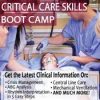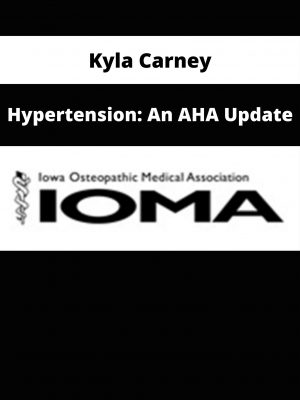Subtotal: $53
Jerome Quellier – Caring For Patients with Tracheostomy & Ventilator Dependency
$219 Original price was: $219.$62Current price is: $62.
Shopping Instructions:
- DISCOUNT 15% : SHOP15
- Product Delivery: Within 1 – 12 hours after purchase.
This recording will outline and compare the basic components of a tracheostomy tube, decision making surrounding the most appropriate type of tube to use for various populations, and the risks/benefits of placement.
Jerome Quellier – Caring For Patients with Tracheostomy & Ventilator Dependency
ANATOMY AND PHYSIOLOGY OF TRACHEOSTOMY
- Definition of terminology used
- Surgical vs. Percutaneous Tracheostomy
CLINICAL FEATURES OF A TRACHEOSTOMY TUBE INTUBATION AND TRACHEOSTOMY – BENEFITS AND RISKS
- Endotracheal tube advantages/disadvantages
- Tracheostomy tube advantages/disadvantages
SIZING TRACHEOSTOMY TUBES
MANUFACTURERS OF TRACHEOSTOMY TUBES
SPECIAL CONSIDERATIONS OF MANAGING A TRACHEOSTOMY TUBE
- Cuff pressures
- Essential daily cares
- Necessary supplies
- Cannula cleaning/exchanging
- Maintaining stoma and skin integrity
- Minimal Leak technique vs. minimal occlusive volume
SPEAKING VALVES
- Anatomy & physiology of common speaking tubes
- Population and timing
- Warning/Precautions
- Assessment and placement guidelines
- Trouble shooting during valve assessment/use
- Ventilator modifications for safety and success
- Inline speaking valves
- Decision making for the respiratory therapists
- Tidal volumes
- Peak inspiratory pressures
- Minimal vent parameters to facilitate successful application
FENESTRATED TRACHEOSTOMY TUBES
DYSPHAGIA AND THE TRACHEOTOMIZED PATIENT
- Post extubation consideration
- Effect of tracheostomy on swallowing
- Effect of cervical bracing on tracheotomized patient
- Assessment of swallowing
- Blue Dye vs. Fees vs. MBSS
- Impact of speaking valve upon swallowing
MULTIDISCIPLINARY CARE OF A PATIENT WITH TRACHEOSTOMY
- Role of SLP, nurse, and respiratory therapist
- Review a sample of policy/procedure
Would you like to receive Jerome Quellier – Caring For Patients with Tracheostomy & Ventilator Dependency ?
Description:
Develop a Comprehensive Management Plan for Adults Living with Acute & Long–Term Tracheostomy
As medical technology and intervention evolves, more patients are faced with temporary and long–term tracheostomy/ventilation as a part of their recovery. The very presence of a tracheostomy tube may elicit visceral reaction to secretion management and dehumanize the patient who is unable to exercise their decision making capacity, orally communicate their needs, and interact socially with staff or family.
Practitioners in acute hospitals, transitional rehabilitation units, skilled long–term settings, and homecare arenas are challenged to not only understand the basic functionality of a tracheostomy tube, but complete daily cares, assist their patients with swallowing and oral communication, and even train non-medical care providers. Management of the tracheostomized patient is often assumed to be complex. This misconception may become a barrier for placement in an environment most conducive to overall rehabilitation; to foster social closeness with staff, friends and family; and ultimately result in prolonging the weaning process.
This recording will outline and compare the basic components of a tracheostomy tube, decision making surrounding the most appropriate type of tube to use for various populations, and the risks/benefits of placement. Through review of daily cares, the assessment and placement of a speaking valve, and dysphagia characteristics for this population, you will build the skills and confidence necessary to develop a comprehensive management plan. Finish this recording with a solid foundation of general knowledge, critical thinking algorithms, and an understanding of the roles and responsibilities of their specialty when faced with tracheostomized patients.
Here’s What You’ll Get in Jerome Quellier – Caring For Patients with Tracheostomy & Ventilator Dependency
Jerome Quellier – Caring For Patients with Tracheostomy & Ventilator Dependency : Sample
Related products
HEALTH & MEDICAL
HEALTH & MEDICAL
KettleWorX – 8 Week Rapid Evolution Advanced Set with Alex Isaly
HEALTH & MEDICAL
HEALTH & MEDICAL
HEALTH & MEDICAL
HEALTH & MEDICAL
HEALTH & MEDICAL
HEALTH & MEDICAL
CC11 Workshop 06 – Magical Moments in Couples Therapy – Jette Simon

 Christian Hudson – The Girlfriend Activation System 2.0
Christian Hudson – The Girlfriend Activation System 2.0  Trader’s Magazine – Technical Analysis of Stocks & Commodities 2010-2016
Trader’s Magazine – Technical Analysis of Stocks & Commodities 2010-2016 











